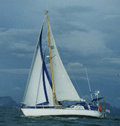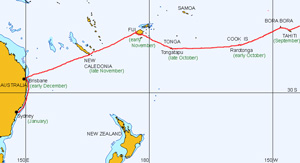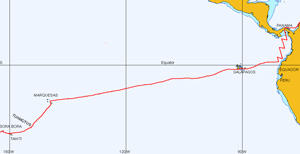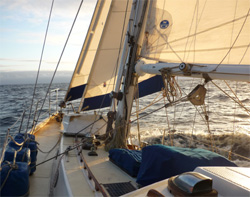Weatherly Sailing Adventures

Click on the map below, to expand in a new window :



Click on the map below, to expand in a new window :

The Pacific ocean is so huge, I couldn't fit the route across it in one map.
So I've divided it into 2 sections, east of Tahiti (above), and
my proposed route westwards from Tahiti (left).
Just after departing the beautiful Las Perlas islands in Panama, Weatherly took a pasting by a rain squall.
Whack!!! After a few hours of drenching rain, the wind suddenly built to 45knots turning the sea to streaks of white and stinging my face as I tried reefing genoa and mainsail in. Not enough reefed in fast enough, and my mainsail was shredded in many long slashes. The genoa ripped down the leech and across the sail in a long, horizontal tear.
Drats! I rigged the storm trysail up the mast and sailed on it and the staysail. I stowed the spare fuel containers down below - as I hadn't spent time to lash them securely on deck - poor seamanship, I know!
It was a sickening feeling having to consider returning the 2 day trip back to Panama. I thought I could manage without the broken gear and started preparing the basic spare mainsail I bought in Cape Verde islands. It needed lugs stitched on, and control lines attached to reefing points and clew.
The next morning in light airs, I took down the genoa and hoisted the yankee, a higher winds sail for beating to windward. I also hoisted the spare mainsail and was making good speed in the light wind, using the motor and mainsail to dampen the rolling motion.
After motoring for more than 12 hours, I noticed some bilge water at the edges of the cabin floor. The water-lock on the engine exhaust line had developed a rust hole in it, and discharge salt water was being pumped through it, into the bilge. I took it off and repaired the hole using a steel putty compound, and replaced it, after painting the box up.
Now the engine driven bilge pump also stopped functioning and I spent hours taking it off and inspecting what was wrong with it. The bearings I gathered. I still had my manual bilge pump and an identical spare one as insurance, which I dug out from the quarter-berth lockers.
I had to tack many times while the currents were minimal, in order to get south enough to reach the Galapagos islands. Hence the large zig-zag plot shown on the map.
The next week was spent tacking back and forth down south towards a small point off Equador, where my friends on 2 yachts were anchored to make rigging repairs. Both had damaged rigging, and luckily, La Barca had spare wire to replace them.
I nearly called in there to meet them, but the wind changed on the morning I was to tack in, so continued on. In any case, I was in HF radio contact with my friends twice a day on organised schedules, and were monitoring each others developments. This also helped morale when tackling problems on the yachts or winds were adverse, and I looked forward to our chats with my friends on 'La Barca' and 'Cygnus II' on the radio.
My manual bilge pump stopped working and I found there was always some water ingress into the bilge. I tracked down it's source - water was slowly syphoning back into the bilge through the pump valves. So I took the pump apart, and discovered the membrane had gone on one side and bolt had come off the other membrane. I had spares, so made the repairs. After replacing the membranes and cleaning sludge from the valves, the pump worked effectively again, and bilge seemed to stay relatively dry.
The weather improved markedly, once away from the coasts of Panama and Equador. Blue sky and consistent wind from the South and even South-East prevailed, at around 15-20knots. The unstable, wet squalls and unpredictable wind shifts were behind me.
The water looked a deep, pure blue in the sunlight, and there was no more surface pollution, as in the gulf of Panama. It was enjoyable sailing, watching the water and sky, and feeling the wind push Weatherly along. In this last week I had winds from the south and it was easy to steer a course now directly for my destination. That was a relief after all the tacking into south west winds in the first week sailing from Panama.
I crossed the Equator on 7th July a little after 7:07am. The numbers amazed me at all the zeros on the GPS and all the 7's in the time. It was Tes' birthday - she was born on 7/7/77. Mystical numeric sequences... I thought to read into that, as though it was time to 'zero-out' the feelings I had for my ex-girlfriend.
Well, for the occasion of crossing the equator into the South Pacific, I dressed up as Neptune, with a trident, thunderbolt, a beard and bushy eyebrows. I crossed at around 86degrees West, and took some photos. The day was clear with a cool, fresh breeze pushing Weatherly along at a great speed. I felt happy at the progress through the swells and the proximity to the Galapagos Islands.
Apart from more gear failures - this time the fridge. The piston inside it had seized and now there was no way to keep my freezer or fridge cold. Remaining fresh vegetables, fish, chicken and meats had to be dumped after a few days. By then I was only 2 days from the Galapagos islands, and I hoped I could get the compressor repaired or replaced there.
After days of very good sailing weather, I had plenty of battery charge from the wind generator there was no need to run the engine, since the fridge had stopped funtioning. When I did start the engine one morning, I found it kept overheating. Fortunately it seemed to be merely an airlock in the fresh water system, and after opening the filler cap to release pressure, and trying a few more times, the engine ran normally again. I was relieved, as this is vital equipment for safety for me- for battery power and getting into and out of ports.
Finally the flashing light / beacon was spotted on San Cristobal island, agreeing with the co-ordinates on my chart.
I'd made it across the first leg of the Pacific ocean.


